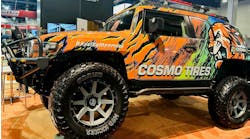Eighty-five percent of tire purchasers are directly influenced by you.” Those 11 words packed as much punch as anything else said at the 2011 Goodyear Dealer Conference in January.
The speaker was Jack Winterton, chief customer officer for Goodyear Tire & Rubber Co.’s North American Tire business unit. He has been with the company for 37 years, which gives him insight into how tire dealers and consumers think during the tire-buying process.
“With 85% of tire purchasers directly influenced by you, our reputations — yours and Goodyear’s — are intently connected. I can’t think of another consumer product whose brand image is as closely linked to the place where the product is purchased.”
That makes you unique, and pretty much the deciding factor when it comes to brand.
Winterton isn’t just waxing philosophic. Results from Modern Tire Dealer’s new “Retail Tire Customer Survey” bear him out.
According to the online survey, 52.5% of the retail customers who come into a dealership to buy tires do not specify brand. Another 25.7% specify a tire brand, but are convinced by the tire dealer to make a different choice.
So, close to 78% of your tire buying customers buy the brand you suggest to them, based on their driving needs, financial means and, in some cases, preferences.
The remaining 21.8% of them specify a brand and buy that brand. However, there’s more to a tire than just a brand name. How often do you suggest the line, or even the size?
I thought so. Add it all up, and Winterton’s 85% estimate might even be a little low. I have talked with many dealers over the years who believe their influence is greater than 85%.
There are other corroborating sources. A 2005 survey from Virginia Polytechnic Institute and State University puts the percentage of consumers who ask for a tire brand at the point of purchase at 30% or less.
When J.D. Power & Associates used to track original equipment tire brand loyalty, it discovered that light vehicle owners replaced their OE brands with the same brands about one third of the time. Keep in mind those were first-replacements. What about the second set of replacement tires?
Our “Retail Tire Customer Survey” addresses the loyalty issue brand by brand for both the first and second replacement sets. Take Michelin, for example.
[PAGEBREAK]
When vehicle owners replace Michelin OE tires for the first time, 32.3% of them buy Michelin again. No other OE brand in our study received loyalty ratings close to that percentage.
Goodyear is second at 24.3%, meaning nearly one-quarter of domestic vehicle owners replace their Goodyear OE tires with the same brand the first time around. The Bridgestone brand is third at nearly 23%, followed by Firestone (19%), BFGoodrich (17.6%), Yokohama (13.2%), Continental (12.7%) and Toyo (11.8%).
Rounding out the OE brands are Hankook (11.1%), Dunlop (11%), Pirelli (10.2%), Kumho (10.2%) and General (9.1%).
When customers replace their tires for the second time, Michelin still comes out on top when it is the OE brand, although the percentage drops to 28.6%.
Not surprisingly, Michelin is among 11 brands with lower percentages the second time around. Only Hankook (11.7%) and General (9.3%) improved their actual or perceived brand loyalty.
Respondents to our survey clearly listed Michelin as the brand most likely to be “the same brand” when both the first and second sets of replacement tires are taken into consideration. Yet Michelin OE tires are only replaced with Michelin replacement tires 30% of the time.
Michelin is batting .300, which is a good batting average. Independent tire dealers are batting .700, which is a great average. That is why typical tire dealers each handle more than 11 different brands. A multiple brand strategy gives them options, and allows them to take advantage of more profitable opportunities.
Your influence never seems to change, which is why the “70/30 Rule” is a generally accepted principle in our industry. It states that from start to finish, you determine the tire brand the customer buys 70% of the time.
The rule does not directly take into account your help when customers ask for a brand, which happens about 30% of the time. About half of them will be switched over to another brand, or 15% of the total.
In all, under the “70/30 Rule” and its ramifications, you significantly influence 85% of the tire brand purchases.
Perhaps Winterton based his estimate on the “70/30 Rule.” Given all the additional statistical research and data available about tire-buying habits, he could have gotten his number from anywhere. And everywhere.
If you have questions or comments, please e-mail me at [email protected].



